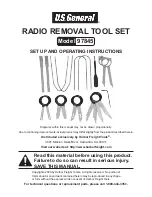
17
TIPS FOR GETTING THE MOST OUT OF YOUR CHILD RESTRAINT
• Before buying any restraint system, make sure that it has a label certifying that it meets all
applicable Safety Standards. The manufacturer also recommends that you try a child restraint
in the vehicle seats where you will use it before you buy it.
• The restraint must be appropriate for your child’s weight and height. Check the label on the
restraint for weight and height limits.
• Carefully follow the instructions that come with the restraint. If you install the restraint
improperly, it may not work when you need it.
• All passenger seat belts are equipped with cinching latch plates.
• Seat belts are designed to keep the lap portion tight around the child restraint so that it is
not necessary to use a locking clip. If the seat belt has a cinching latch plate, pulling up on the
shoulder portion of the lap/shoulder belt will tighten the belt (the cinching latch plate will keep
the belt tight; however, any seat belt system will loosen with time so check the belt occasionally
and pull it tight if necessary).
• If the belt still cannot be tightened, or if pulling and pushing on the restraint loosens the belt,
disconnect the latch plate from the buckle, turn the buckle around and insert the latch plate
into the buckle again. If you still cannot make the child restraint secure try a different seating
position.
• Buckle the child into the restraint exactly as the manufacturer’s instructions tell you.
• When your child restraint is not in use, secure it in the vehicle with the seat belt or remove it
from the vehicle. Do not leave it loose in the vehicle. In a sudden stop or collision it could strike
the occupants or seat backs and cause serious personal injury.
NOTE: For additional information refer to seatcheck.org or call 1-866-SEATCHECK.
OTHER CHILDREN AND CHILD RESTRAINTS
Children who weigh more than 20 lbs (9 kg) and who are older than one year can ride
forward-facing in the vehicle. Forward-facing child seats and convertible child seats used in
the forward-facing direction are for children who weigh 20 to 40 lbs (9 to 18 kg), and who
are older than one year. These child seats are also held in the vehicle by the lap/shoulder belt.
The belt-positioning booster seat is for children weighing more than 40 lbs (18 kg), but who
are still too small to fit the vehicle’s seat belts properly. If the child cannot sit with knees bent
over the vehicle’s seat cushion while the child’s back is against the seat back, they should use
a belt-positioning booster seat. The child and belt-positioning booster seat are held in the
vehicle by the lap/shoulder belt.
CHILDREN TOO LARGE FOR BOOSTER SEATS
Children who are large enough to wear the shoulder belt comfortably, and whose legs are
long enough to bend over the front of the seat when their back is against the seat back,
should use the lap/shoulder belt.
• Make sure that the child is upright in the seat.
• The lap portion should be low on the hips and as snug as possible.
• Check belt fit periodically. A child’s squirming or slouching can move the belt out of
position.
• If the shoulder belt contacts the face or neck, move the child closer to the center of the
vehicle. Never allow a child to put the shoulder belt under an arm or behind their back. Not
all child restraint systems will be installed as we have described here. Again, carefully follow
the instructions that come with the child restraint system.
TRANSPORTING PETS
Pets should be restrained in a pet harness or in a pet carrier that is secured by seat belts.
















































